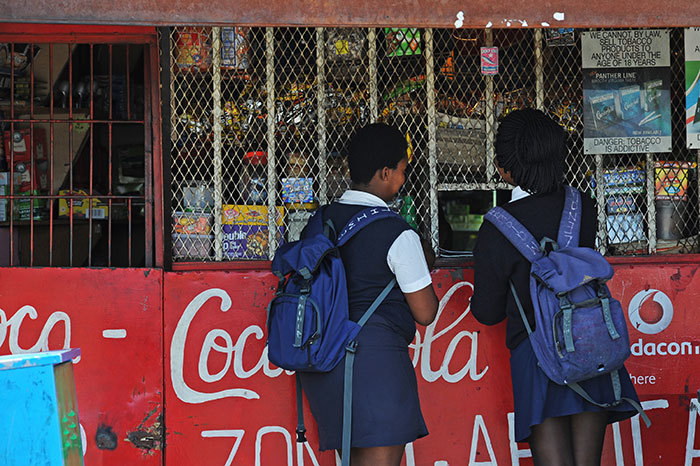Feast your eyes
10 January 2014
Nearly 50% of food ads – predominantly for franchised fast food, sweetened drinks and desserts – flight during family viewing times. What are the implications for the food choices and health of young children in South Africa, and what can be done about it?
Research published in the March edition of the Human Sciences Research Council's Policy Brief shows that adverts for franchised fast food, starchy foods, sweetened drinks, and desserts and sweets dominate the advertising material in family viewing time between 17h00 and 19h00.
Nearly 50% of food ads appear during this slot.
Equally concerning is that 67% of alcohol adverts are flighted during family and children's viewing time, the latter between 15h00 and 17h00. This raises huge ethical questions about what is advertised to children, says co-author Dr Nelia Steyn of UCT's Division of Human Nutrition.
Adverts for health-enhancing foods such as fruit and vegetables made up only 1% of advertising.
The findings are based on research in 2012 by the HSRC, the South African Medical Research Council and Athabasca University, Canada. The research surveyed the extent of food advertising to children by the SABC across its four broadcasting stations.
The researchers found that most food ads shown to children and adults did not encourage healthy eating, despite claims to the contrary, as the foods were high in fat, salt and/or sugar.
While there are regulations about labelling food products, there are, as yet, none governing advertising food to children on TV, says the report.
It adds that in 2007 the Department of Health published a draft Foodstuffs, Cosmetics and Disinfectants Act, which included prohibitions on advertising unhealthy foods: crisps, confectionery, fast food and fizzy drinks.
But the draft act was put on hold following an outcry from industry and the public.
The outcomes are reflected in the rising incidence of obesity and non-communicable diseases such as diabetes and heart disease, says Steyn. "And these patterns are often set in childhood," she adds. "Government is aware of it; there's been a lot of research, and it's time they made a commitment."
In 2012 Steyn and her co-investigators wrapped up a four-year research project in 100 lower-quintile Western Cape schools in rural and urban settings to isolate factors that contribute to non-communicable diseases such as diabetes and heart disease.
The province carries a high burden of diabetes, and being overweight is a contributing risk factor. The project focused on the schools' pupils, their parents and their teachers.
Of the children who bought food at the school tuckshops, most chose filling, energy-dense foods; fried food and food high in sugar and fat – the infamous chip roll (a bread roll filled with crisps) leading the way.
"They are hungry children; they want full tummies," says Steyn, adding that their choices should be seen against a broader backdrop; a mixed bag of societal dysfunction: poverty, gangsterism, sexual abuse and violence, and alcohol and drug abuse.
In this light, nutrition and exercise are non-issues. (After Steyn's interventions at the schools, they measured improvements in nutrition knowledge, but not in behaviour.)
"Their priorities are more extreme."
School tuckshops were also not about food: in many schools these facilities are run primarily for profit and fundraising purposes. Little attention is paid to providing healthy options, which also tend to be more expensive.
Steyn suggests a simple intervention: government should issue a list of prohibited food and drink items for tuckshops and feeding schemes.
"The Department of Health must lead this initiative," she adds. "And it should be extended to school events and sports days."
But perhaps the most perturbing finding of the research is that teachers were identified as a high-risk group.
More than 70% of the educators surveyed were overweight or obese. Not only were they inactive; they also had "unacceptably high" cholesterol and glucose levels; higher than the average adult.
While Steyn points to their difficult and often demoralising working conditions, she's concerned that they make poor role models for thousands of impressionable children.
"We want to develop a wellness programme for our teachers, something that's internet-based and sustainable; something they can take home."
A healthy take-out.
Story by Helen Swingler. Photo by Michael Hammond.
Read more:
Baby fatSaddle up
Tipping the scales: SA's kids too fat, too sedentary
 This work is licensed under a Creative Commons Attribution-NoDerivatives 4.0 International License.
This work is licensed under a Creative Commons Attribution-NoDerivatives 4.0 International License.
Please view the republishing articles page for more information.










